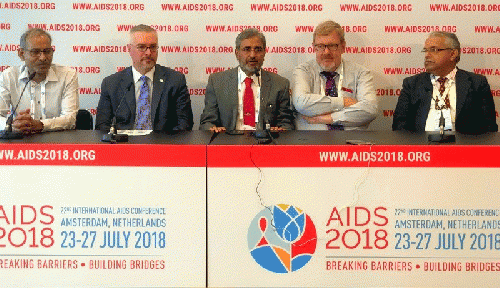
If business as usual continues we will fail to end AIDS: AIDS 2018 Experts
(Image by CNS (Citizen News Service)) Details DMCA
"Tremendous progress against AIDS over the past 15 years has inspired a global commitment to end the epidemic by 2030. Out of the total 36.9 million people living with HIV (PLHIV) globally, 21.7 million of them were on antiretroviral therapy (ART) by 2017. But we should also note that 1.8 million people were newly infected with HIV in 2017" said Dr Ishwar Gilada, who was Chairing a session at 22nd International AIDS Conference (AIDS 2018) in Amsterdam, Netherlands.
"If we are to meet the UNAIDS 90:90:90 targets and Sustainable Development Goals (SDGs) - one of which is to #endAIDS by 2030 - we cannot afford to slacken HIV prevention or delay provision of ART to every PLHIV and monitor viral load" added Dr Ishwar Gilada, who is also the President of AIDS Society of India (ASI), and among the first doctors who began HIV care in India when first case got diagnosed in the country.
Looming danger of sidelining HIV prevention
Dr Gilada also highlighted the looming danger of sidelining HIV prevention in recent years. "Global new HIV infections have declined by just 18% in the past seven years: from 2.2 million in 2010 to 1.8 million in 2017. If business as usual continues, then we will fail to reach the target of less than 500,000 new HIV infections per year by 2020," he warned. He said the global community is able to think and strategize for the likes of Test and Treat policy or 90:90:90 target and dare to dream of the target like #endAIDS by 2030, only because of India's role in making ART affordable and accessible - at almost 1-3% of global cost and today India is able to meet 92% of global requirement of ART.
"UNAIDS too warned before AIDS 2018 that the global response to HIV is at a precarious point and the pace of progress is not matching global ambition, calling for immediate action to put the world on course to reach the critical 90:90:90 targets by 2020 (that is, 90% of all PLHIV will know their HIV status; 90% of the people diagnosed with HIV infection will receive sustained antiretroviral therapy (ART); and 90% of all people receiving ART will have viral load suppression)" shared Shobha Shukla, Executive Director, CNS (Citizen News Service).
New action plans needed for a breakthrough
Professor Dr Jurgen Rockstroh of University of Bonn in Germany and Governing Council member of International AIDS Society (IAS) said that, "Despite recent improvements in accessing HIV treatment and care in the region, the response to the HIV epidemic still faces many challenges. Only 28% of the estimated PLHIV in eastern Europe and central Asia were reported to be receiving HIV treatment in 2016, is far below the western and central Europe average of 76% and the global average of 53%. This indicates an alarming situation in the region as a whole to move towards achieving these targets. Furthermore, about half of the people diagnosed with HIV are diagnosed at late stages and lifesaving treatment gets delayed. Many PLHIV thus start treatment too late and already show signs of widespread immune system damage, leading to excess morbidity and mortality. New action plans are needed to achieve a breakthrough."
Can we afford to slow down momentum against AIDS?
(Note: You can view every article as one long page if you sign up as an Advocate Member, or higher).





